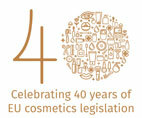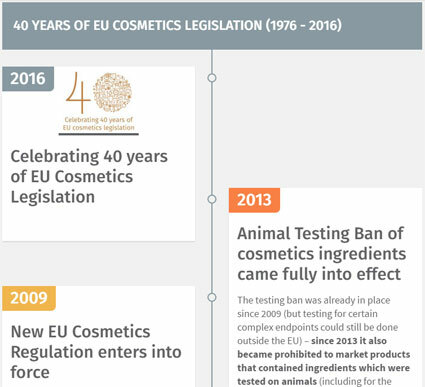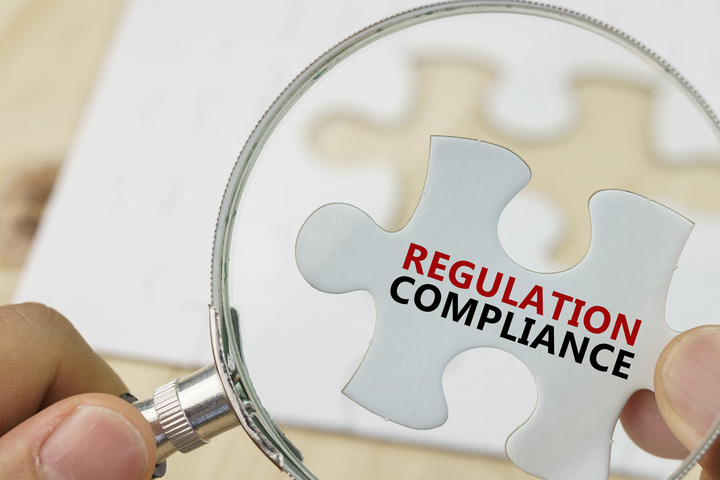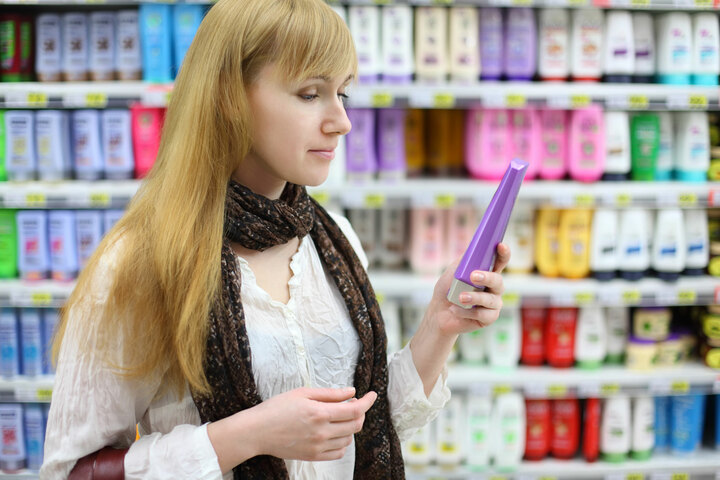The Single Market - the term used to describe the free movement of goods, capital, people and services within the Member States of the European Union - is a cornerstone of the European Union. In order for it to work for a specific product sector, there must be similar legislation in place in all the Member States. For example, if a product is to move freely within the European Union, the same labelling, packaging and safety regulations must apply. In the early 1970’s the Member States of the European Economic Community (now called the European Union - EU) decided to harmonise their national cosmetic legislations in order to enable the free circulation of cosmetic products within the Community, on the basis of commonly agreed safety standards. The Cosmetics Directive was adopted in 1976. This Directive was reevaluated in 2009 to enable further harmonization and a EU-wide Cosmetics Products Regulation entered into force in July 2013.
The philosophy of the Cosmetics Regulation is that all products meeting the requirements of the Regulation should have equal and immediate access to the market and should be able to circulate freely throughout the European Union. In the EU, it is strongly believed that for fast moving consumer products, such as cosmetics, an in-market control system (also known as post-market control) is more effective than pre-market approval procedures. The key principle of the Cosmetics Regulation is that the person or company who places the cosmetic product on the market is responsible for that product (so called ‘Responsible Person’). It is the responsibility of that person or company (usually the manufacturer or the importer) to ensure that the product is safe and meets all the requirements of the Cosmetics Regulation. All stages of the development of the cosmetics product is regulated by the Cosmetics Regulation, from the choice of ingredients to the placing on the market of the product.
How we make your products
R&D
Innovation is not a buzzword in our industry: it has to be at the absolute core of what we do. Our R&D programmes delve into consumer behaviour and beauty aspirations, the biology of skin and hair, to new innovative technologies and sustainable development methods.
This allows us to select and develop the ingredients that are most respectful of human health and the environment, and to subsequently create or re-develop products that respond to the ever-changing expectations of consumers.
Innovation in our industry is not short-term. It can take over 5 years of innovative research and formulation to bring a new product to the market. Nor is it static: every year, 25% of all cosmetic products are improved or are completely new. For this reason, a large proportion of patents granted in the EU are for our industry’s products (the record being 10% of all patents awarded in the EU in 2009).
Choosing ingredients
Ingredient selection is dictated by the EU Cosmetics Regulation, which lays down all rules for product and ingredient safety assessments. It lists all substances that must not be used owing to their toxicity, substances that can only be used in specified circumstances, and the substances approved for use in cosmetics like colouring agents, preservatives and UV filters.
Our industry fully supports the safety objectives of the Cosmetics Regulation and works to ensure that information about products and ingredients is available to consumers.
Myths and internet rumours: An oft cited, but utterly unfounded, internet myth suggests that lipsticks contain lead and could cause cancer or other adverse health effects. The Cosmetics Regulation specifically bans the use of lead in cosmetics, and our industry is in full support of the Regulation’s measures. Moreover, a comprehensive safety assessment is completed on every product that is being placed on the market by the manufacturer, which would discover any breaches of the regulation.
An old internet rumour that is routinely re-circulated claims that Sodium lauryl sulphate/sodium laureth sulphate (SLS/SLES) can cause irritation and possibly even cancer. SLS is a surfactant which enables a liquid to foam and is used in many cosmetic products for its cleansing and emulsifying properties. Neither the European Commission, nor its scientific advisory committee, SCCS (the Scientific Committee on Consumer Safety), nor any individual Member State has ever questioned the safety of SLS despite extensive testing.
Assessing for safety
Consumer safety is the overriding objective for the manufacture and sale of cosmetics in Europe, and the foremost responsibility for product safety lies with manufacturers.
To meet their obligations under the EU Cosmetics Regulation, companies must fulfil specific duties before placing a product on the market, including:
- A safety assessment (for which results must be made available for inspection)
- Provision of product information
- Compliance with ingredient and labelling rules
Specifically, the Cosmetics Regulation requires safety assessments to take account of product ingredients, chemical structure and level of exposure. The safety assessment must pay particular attention to where the product will be applied (e.g. eyes, mouth or scalp) and which population group is expected to use it.
Cosmetic products for children under the age of three, and those intended exclusively for use in external intimate hygiene, must undergo a specific safety assessment that takes account of their special needs, for example, their higher skin surface area to body weight ratio.
The person who carries out the safety assessment must have adequate qualifications and relevant experience, and hold a recognised diploma in pharmacy, toxicology, dermatology, medicine or a similar discipline.
Product Preservation
Preservatives are included in cosmetic formulations to ensure that products are safe to use for a long time by protecting them from contamination by microorganisms present in the air, water and on our own skin. Cosmetic products contaminated with bacteria and yeasts can cause irritations or infections. Without preservatives, cosmetics would have to be kept cool and would spoil in the same way as perishable food.
Many products will display an open jar symbol showing how many months they can be used once they are open. Before opening, most cosmetics will remain stable and free from contamination for many years.
Strict rules govern the inclusion of preservatives in cosmetics. Manufacturers must choose from a set list of preservatives listed in the EU Cosmetics Regulation, which have been subjected to stringent scientific tests and approval procedures before they are permitted for use, including a review by the SCCS.
Most cosmetics need preservatives, including products made from natural ingredients such as jojoba, fruit pulp and plant extracts. There are a few exceptions, like perfumes, deodorants and hair sprays with high alcohol content, for example. For all other products, preservatives have an important and beneficial role to play.
Allergy to preservatives is rare but a very small number of people could have an allergic reaction to certain substances. The ingredients in cosmetic products are labelled in accordance with EU legislation and use the same labelling terms throughout the EU and in many countries around the world. This means that people with a known allergy can check the ingredients list before purchase to ensure that the product does not contain ingredients to which they have been diagnosed as allergic.
Alternatives to animal testing (AAT)
In summary, this is the status of animal testing in relation to our industry in the EU:
- Animal testing of cosmetics products is banned
- Animal testing of cosmetic ingredients is banned
- Selling cosmetic products tested on animals is banned
- Selling cosmetic products containing ingredients tested on animals for the purpose of complying with the Cosmetic Products Regulation is banned
As a result, our industry needs to be at the forefront of research into and development of alternatives methods, defined as those that achieve the “three Rs”:
- Replacement of animal tests with non-animal approaches
- Refinement of an animal test to reduce or eliminate stress or suffering
- Reduction in the number of animals needed in a test
However, since the European cosmetics industry is subject to bans relating to animal testing, we are looking for those alternatives that replace animal testing.
Indeed, Cosmetics Europe and its members are at the forefront of developing non-animal testing worldwide. For more than 20 years our industry’s best scientists and its strategic partners have been dedicated to support the development, validation and/or regulatory acceptance of alternative test methods and approaches.
Read more about our AAT activities
Developing your cosmetics
Manufacturing according to Good Manufacturing Practices (GMP)
The EU Cosmetics Regulation stipulates that all cosmetics products must be manufactured in accordance with the harmonised standards laid out in GMP, in turn described in the Official Journal of the European Union.
GMP ensures that products are prepared in a clean environment and that the products are not contaminated in production. Microbial contamination can be quite common as many microorganisms live freely in the atmosphere around us, and could lead to degradation and, in severe cases, could cause harm to the consumer.
Placing a product on the market
Before being placed on the European market, all cosmetics products must be listed on a centralised database, the Cosmetic Products Notification Portal (CPNP), managed by the European Commission. When a product has been notified in the CPNP, there is no need for any further notification at national level.
The CPNP is available to the following organisations:
- Competent authorities for the purposes of market surveillance, market analysis, evaluation and consumer information
- Poison centres or similar bodies established by EU member states for the purposes of medical treatment
- Cosmetic products “responsible persons” e.g. manufacturers
- Distributors of cosmetic products
Reaching you
Marketing/Advertising
Advertising is an important part of the interaction cosmetics brands have with consumers. It conveys how the products work, whom they are for and how best to use them, ultimately providing the information that helps them make informed choices.
The EU Cosmetics Regulation sets the principles for claims that manufacturers can make on their packaging. This is complemented by the common criteria on claims regulation and guidelines that outline how claims should be made.
In addition to the regulatory framework, we have a self-regulatory initiative that dictates responsible advertising on elements such as taste and decency, advertising to children, and respect for the human being. Cosmetics Europe has published the ‘Charter and Guiding Principles on responsible advertising and marketing communication’ to assist members.
See our section on informing the consumer for further information.
Labelling
The EU Cosmetics Regulation includes a set of strict rules for labelling of cosmetic products, all of which must be present on the product container, packaging, or if not possible given space restrictions, in an enclosed leaflet. Without proper labelling, a product will not be permitted onto the market.
Labelling requirements include:
- The name or registered name and the address of the Responsible Person. The nominal content at the time of packaging, given by weight or by volume
- The date until which the cosmetic product, stored under appropriate conditions, will continue to fulfil its initial function
- The date of minimum durability (if less than 30 months)
- Particular precautions to be observed in use
- The batch number of manufacture or the reference for identifying the cosmetic product
- The function of the cosmetic product, unless it is clear from its presentation
- A list of ingredients
- The list of ingredients shall be established in descending order of weight
Read understanding the label for further information on labelling requirements of cosmetic products.
Responsibilities of distributors
While the Responsible Person, usually the manufacturer, is responsible for a majority of the rules set out in the EU Cosmetics Regulation, distributors also hold special responsibilities.
They must verify that labelling information is correct and that the date of minimum durability has not passed. Furthermore, if they believe that a cosmetic product is not in conformity with the requirements laid down in the Regulation, they may not sell it, and if they believe a product poses a health risk, they must report it to the Responsible Person and the competent national authorities of their member state. Lastly, they must ensure suitable storage and distribution conditions.
You & your product: ongoing surveillance
Cosmetovigilance
Under the Cosmetics Regulation, the system of cosmetovigilance, whereby serious undesirable effects must be reported to the Responsible Person and relevant authorities, ensures that the safety of cosmetic products placed on the EU market is monitored throughout Europe.
A competent authority of the member state in which an undesirable effect occurs must inform the competent authorities of other member states. Moreover, if serious undesirable effects are reported to the competent authority of the member by end users or health professionals, that competent authority must transmit the information to the competent authorities of other member states and to the Responsible Person.
Market surveillance
Companies and competent authorities are also engaged in monitoring the safety of products on the market by performing Appropriate checks of cosmetic products and companies manufacturing, marketing and retailing those products. This is done through the product information file and, where appropriate, physical and laboratory checks on the basis of adequate samples. Member states must also monitor compliance with the principles of good manufacturing practices.
Reviews and assessments of the work of the market surveillance authorities must be carried out at least every four years.
40 Years of EU Cosmetics Legislation (1976 - 2016)
-
2016

Celebrating 40 years of EU Cosmetics Legislation
-
2013
Animal Testing Ban of cosmetics ingredients came fully into effect
The testing ban was already in place since 2009 (but testing for certain complex endpoints could still be done outside the EU) – since 2013 it also became prohibited to market products that contained ingredients which were tested on animals (including for the toxicological endpoints that were exempted in 2009 – as from 2013 the ban is complete both for testing and marketing)
-
2009
New EU Cosmetics Regulation enters into force
Followed by an adoption in 2009, the year of 2013 finally marks the ‘apotheosis’ of the harmonised cosmetics legislation in the EU. Changing the legal form from a Directive to a Regulation means that the EU legal text no longer needs to be transposed into the national legislation of the Member States (sometimes slow and imperfect), but the EU text is as such the directly applicable law in all EU Member States.
The new Regulation also introduced a single, electronic product notification system (CPNP) that replaced the more than 20 different national systems existing at that time
-
2004
Enlargement / TAIEX
During several rounds of EU Enlargement a total of 22 new Member States adopted the EU Cosmetics Directive since 1976 and implemented it into their national laws.
Each time, significant preparatory work was carried out between the accession countries, both at industry level and authorities’ level, and the EU Commission and industry associations. So-called TAIEX seminars allowed the accession countries to get a good understanding of the harmonised EU legislation, including on cosmetics. This ensured a smooth transition and integration of these countries and their products into the EU internal market
-
2003
7th Amendment to the Cosmetics Directive
Besides refined consumer information requirements on the presence of certain allergens and on product durability, this amendment brought two major changes:
- The animal testing bans for cosmetic ingredients, which up to this time were dependent on the availability of alternative methods, were linked to fixed deadlines (2009 and 2013) – irrespective of the scientific progress and availability of alternative methods
- A categorical, hazard based ban in cosmetics of the use of substances classified under the Chemicals legislation as CMR Cat 1A or 1B – irrespective of whether such use in cosmetics is safe or not
-
2001
A new approach to chemicals legislation in the EU with REACH
Chemicals placed on the EU market – be it as such or as part of a finished product, need to be registered with a safety data package and a human and environmental safety assessment. Cosmetic ingredients are covered by this registration obligation.
REACH is the most important piece of environmental legislation for the substances used in cosmetics
-
2000
First Alternative Method Validated / Accepted for Cosmetics
The term “alternatives” was coined by the distinguished physiologist David Smyth in his 1978 book Alternatives to Animal Experiments. It is used to describe any change to established scientific procedures that will result in the replacement of animals.
Alternative Skin irritation tests became available in 2000 after they had been validated by ECVAM and adopted by the EU and OECD.
Already during the 1960s the biologist Bruce Ames developed an alternative method i.e. an in vitro test in bacteria that still carries his name and that is still used as a relatively inexpensive way to assess the mutagenic potential of many substances including cosmetic ingredients
-
1997
Addressing new challenges for Risk Assessment and Risk Management
In the wake of the BSE food crisis, the EU Commission decided to clearly separate the functions of risk assessment (SCCS) and risk management (legislation) to ensure their independence. Since then, the two responsibilities are managed by different Departments / Directorate Generals in the EU Commission
-
1993
6th Amendment to the Cosmetics Directive 76/768/EEC
This Amendment refined and completed the main principles of the EU Cosmetics Regulation which have since become the model and inspiration for many emerging regions of the world:
- Risk-based regulation aiming at a high level of consumer protection
- Mandatory safety assessment of every product placed on the market, to be carried out by a suitable trained safety assessor
- Every product must have a comprehensive technical information file that is accessible to control authorities during in-market control
- Industry responsibility represented by the ‘Responsible Person’
- Member States authority obligation to carry out effective in-market control
- Full ingredient labeling using INCI nomenclature
Consumers can, with help of the INCI (International Nomenclature of Cosmetic Ingredients) name, recognise ingredients on the label when buying a cosmetic product anywhere in the EU
-
1990
Positive List of UV Filters
The EU - with the support of its scientific committee SCCS – set up a list of substances that can be used as UV filters in cosmetics. Whilst the data requirements for new UV filters are high, they are clearly described by the SCCS guidelines and industry can operate in a predictable and transparent approval environment. This has allowed the EU industry to become the global leader in UV filters sun protection
-
1980
Positive List of Preservatives
The EU – with the support of its scientific committee SCCS - set up a list of the substances that can be used as preservatives in cosmetics and the conditions / concentrations that need to be respected.
Cosmetic companies can only use those substances as preservatives. Any new preservative must first be evaluated, found safe by the SCCS and added to the list before it can be used
-
1979
Establishment of the Scientific Committee on Cosmetology (SCC – now abbreviated SCCS)
The EU created a panel of independent experts, chosen for their scientific excellence and independence to advise on safety of cosmetic ingredients in a transparent manner and on science-based reasoning.
Renewed several times over the years, this committee is internationally recognized and its opinions serve as the basis for regulatory decisions beyond the EU
-
1976
Adoption of the Cosmetics Directive 76/768/EEC
The Member States of the European Economic Community (now called the European Union - EU) decided to harmonize their national cosmetic regulations in order to ensure a high level of consumer protection and enable the free circulation of cosmetic products within the Community









